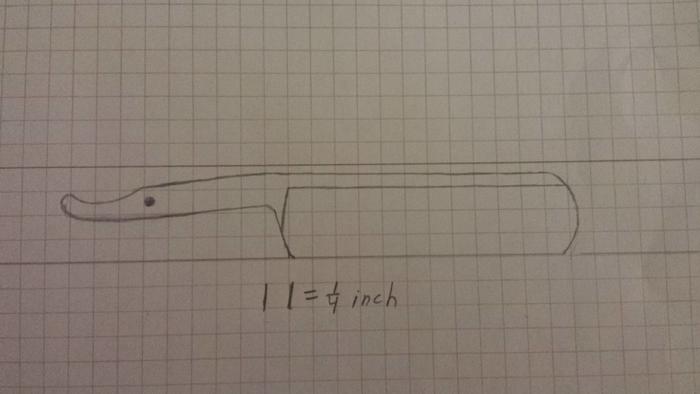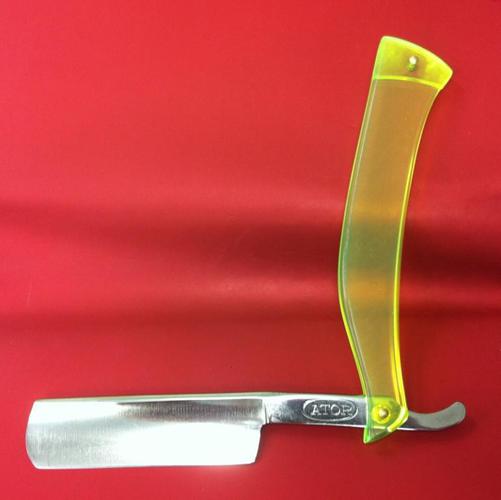Results 1 to 10 of 86
Hybrid View
-
06-04-2014, 04:03 AM #1Senior Member

- Join Date
- Jun 2014
- Location
- Eastern Washington State USA
- Posts
- 406
Thanked: 59 First Straight Razor Build (A learning Process)
First Straight Razor Build (A learning Process)
I would like to build a straight razor myself and post the progress here. The point of posting my progress is two-fold. First, is that it may help others who are trying to do the same thing. Second, is that the other members here may see me making a mistake and point me in the right direction before I go too far down the rabbit hole (been there, done that, bad idea, etc...).
I have made many hundreds of knives in the past but this is my first attempt at a straight razor and I realize that a much of what I know will have to be un-learned. Razors look to have a lot of differences between them and hunting/kitchen knives. Grind geometry, edge angle, desirable steel qualities all look to be different than what I am used to.
Please let me know if this is the correct place for such a thread and I will proceed accordingly.
Thanks!
-
06-04-2014, 04:54 AM #2Senior Member




- Join Date
- Nov 2012
- Location
- Across the street from Mickey Mouse in Calif.
- Posts
- 5,320
Thanked: 1185
Looks like the right place to me :<0) Welcome and good luck. There are lots of threads to read on the processes used and my eyes are still bleeding from reading myself.
Good judgment comes from experience, and experience....well that comes from poor judgment.
-
06-04-2014, 05:17 AM #3Senior Member

- Join Date
- Jun 2014
- Location
- Eastern Washington State USA
- Posts
- 406
Thanked: 59
Thanks, I have been reading posts on here quite a bit lately as well and am about ready to start the process. However I wanted to bounce some ideas off of the members here before ordering parts.
The first thought I had was to choose the steel. Below is a list of the steels I am considering and why I thought that they may work well based on my knowledge and experience with them. I would prefer to use use the stock removal method over forging unless there is a significant advantage to forging (My current forge is only about one third finished). Any thoughts or opinions would be appreciated.
1070/1085 – Basic Good 'ole Fashioned High Carbon Steel. The last two digits indicate the carbon percentage (Example: 1085 has .85% carbon). It is inexpensive, easy to work and sharpen. It should get a fine edge as well as heat treat easily with oil.
1095 – Basically the same as above but with more carbon. It is easier to find in flat stock, but is harder to heat treat (needs a faster cooling oil or water). I may send it out to be professionally heat treated if I go this way.
5160 – Similar to 1095 but more alloys to make it a “spring steel”. The appealing thing with this is that there is an abundance of it around here in the form of old car springs. I've forged quite a few hunting knives from leaf and coil springs. In the end, I thought that it was too “soft” for a hunting knife, but now that I look at it in the light of straight razors, it may be a good option.
O1 – A high carbon Tool Steel. Looks to be popular as a razor material and is easy to find around here. I made quite a few hunting knives out of this and it was a pleasure to work with. It is significantly more expensive than 1095 and I'm not sure if it would make a noticeable difference over 1095.
52100 – High carbon “bearing steel”. This is known for getting a very fine edge. I made one hunting knife out of this and I was amazed how easy it to get it “scary sharp”. It's hard to find around here in a variety of sizes. It's often sold as forging stock and is not always easy to find in smaller flat bar. It is also significantly more expensive than 1095.
ATS-34 – My favorite “all-round” stainless steel. It is relatively inexpensive and easy to find in small flat stock. I have read of some people saying that it is hard to hone, but after grinding on steels such as D2 or CPM S-30V, working with ATS-34 is like cutting butter.
-
06-04-2014, 04:10 PM #4Senior Member

- Join Date
- Mar 2011
- Location
- Corcoran, Minnesota
- Posts
- 665
Thanked: 170
I've used O1 and like the results. I just made some knives from 1095, and I'm sure that would work well also. You are in luck, living in eastern Washington. You don't live too far from Mike Blue, who knows more about steel that just about anyone out there. He is on this forum, and I'd strongly suggest PM-ing him and trying to set up a visit. A great guy, and an amazing resource. He will also doing custom heat treating in molton salt. Good luck on your razor journey.
-
The Following User Says Thank You to skipnord For This Useful Post:
DVW (06-05-2014)
-
06-05-2014, 03:06 AM #5Senior Member

- Join Date
- Jun 2014
- Location
- Eastern Washington State USA
- Posts
- 406
Thanked: 59
I sent him a PM. Thanks for the pointer. While I debate the type of steel, I drew up a sketch of the blade. The goal is to have something that is fairly basic, relatively easy to make, looks good and easy to use for a beginner (me). What I came up with was a blade about 3 inches long, by about 7/8 inches wide and 1/8 inch thick at the spine. Thoughts??

-
06-05-2014, 04:53 AM #6Senior Member




- Join Date
- Nov 2012
- Location
- Across the street from Mickey Mouse in Calif.
- Posts
- 5,320
Thanked: 1185
1/8 is too thin. There is a formula around here for thickness to width. As I recall it is somewhere around 15 to 19 degrees angle on the bevel. You can do the math or search out the formula. ( In case I don't find it for you ) From my reading and being in the same boat as you I started with O1. I have some RSO's but have yet to finish enough to start heat treating. Which I may also have done by pro the first time. To anxious to have one of my own made and use it to mess up 6 blades learning to heat treat. Mike Blue is THE guy to listen too when it comes to steel. If I lived where you do I would probably be camped on his shop doorstep :<0)
Okay I found a place to start. I got 1/4 " stock and took it down to 3/16 for a 5/8 blade. Shooting from the hip is my style, checking for accuracy after.
http://straightrazorpalace.com/advan...pers-tape.htmlLast edited by 10Pups; 06-05-2014 at 04:59 AM. Reason: edit angle:<0)
Good judgment comes from experience, and experience....well that comes from poor judgment.
-
06-10-2014, 12:37 AM #7

DVW,
you original design looks a lot like my Ator
it was 8/8" now just ove 7/8" (after a frown removal) and it has a 1/8" spine
so far I have not fully honed it and needs more time on the Bevel setting
it is a thin full hollow belly ground blade & a real PITA to hone due to flex in the blade
note the scales are 1/8 (3mm) thick acrylic


so they have been made in 1/8" but very flexibleSaved,
to shave another day.
-
06-06-2014, 02:47 AM #8Senior Member

- Join Date
- May 2014
- Location
- South East Idaho
- Posts
- 103
Thanked: 24
Recycling old springs is a fun way to make knives... (or straights I would imagine I haven't made one) but as cheap as you can get a price of steel to build a razor out if I think I would just buy a little chunk and start from there. The problem with old springs is you sometimes have little stress fractures in the steel which can cause your steel to fail during the heat treat. I guess you would only be out your time if you have some springs laying around.... but sometimes having to start over can get discouraging. Just a thought.
-
06-07-2014, 09:10 PM #9Senior Member

- Join Date
- May 2014
- Location
- South East Idaho
- Posts
- 103
Thanked: 24
Looks like a good start
-
06-08-2014, 02:24 AM #10Senior Member

- Join Date
- Mar 2011
- Location
- Corcoran, Minnesota
- Posts
- 665
Thanked: 170
You can control the air flow from your shop vac by partially blocking the air inlet. That's how I control the air from my squirrel cage blower to my coal forge. It can be as simple as a piece of stiff cardboard. Good luck with your project.
-
The Following User Says Thank You to skipnord For This Useful Post:
DVW (06-08-2014)


 71Likes
71Likes LinkBack URL
LinkBack URL About LinkBacks
About LinkBacks






 Reply With Quote
Reply With Quote
